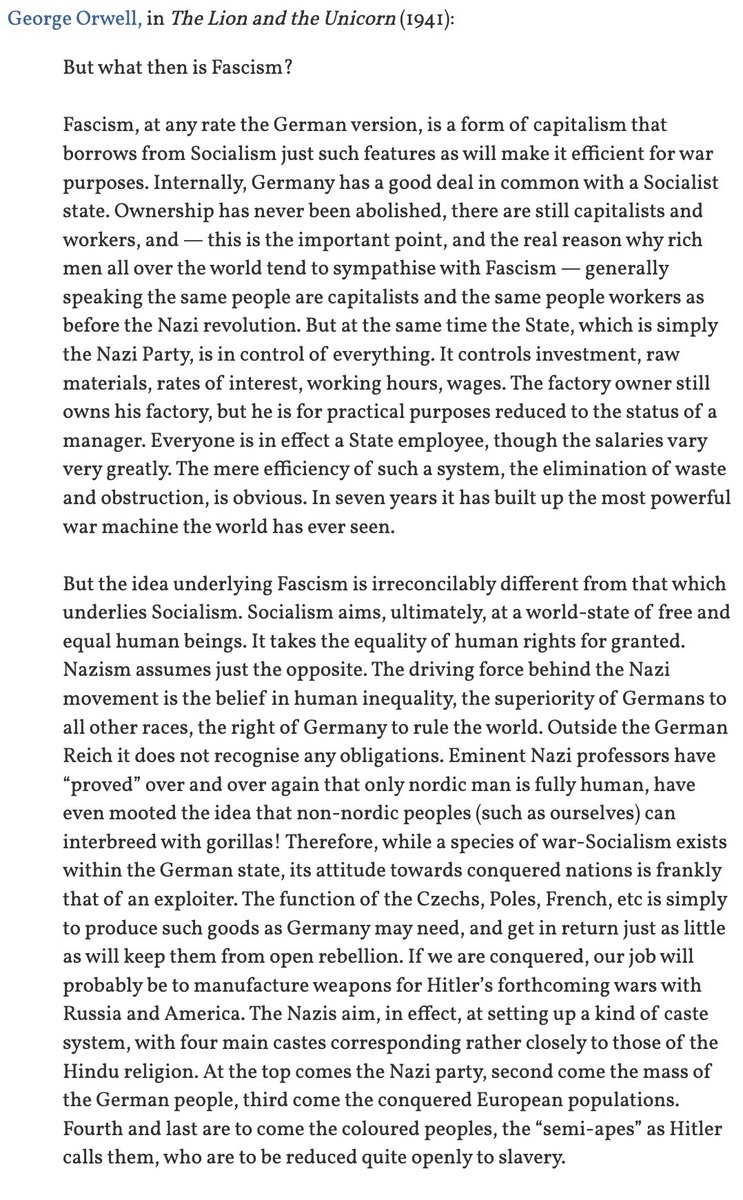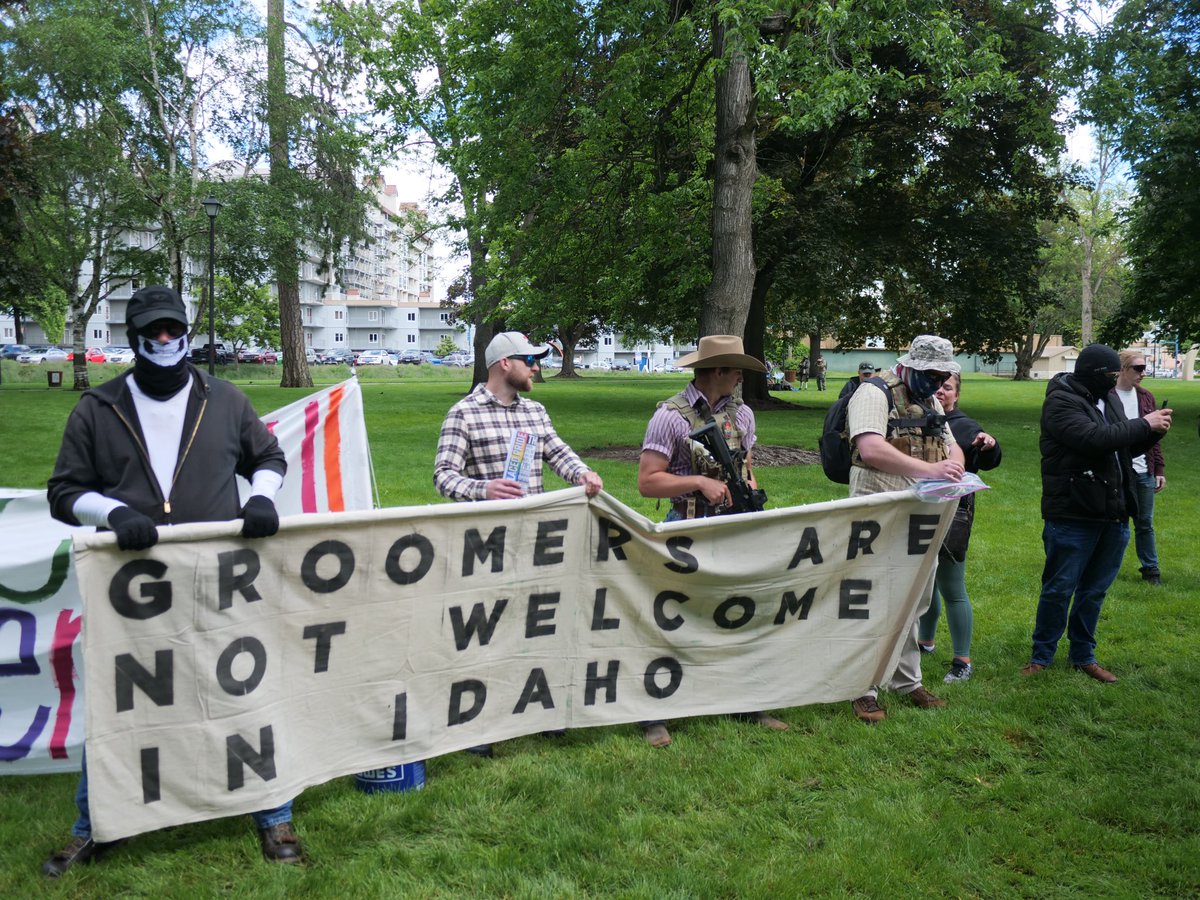Idaho’s far-right extremists—first claiming that the hate-crime attack on the University of Utah women’s basketball team in Coeur d’Alene two weeks ago was a “hoax,” now saying it’s not a real crime—seem confused. So let me explain how the law got passed in Idaho in 1983. 1/49






This a tale of the wages of hate, by which I mean vicious, unrepentant bigotry intended to harm: How it terrorizes and toxifies whole communities, and how its practitioners behave stupidly, even when they think themselves to be smart. In the end, hate is stupid, but it hurts. 2/
The first sign of hate I saw in northern Idaho was the fliers. No one knew who was handing them out, but several came across my editor’s desk at the Sandpoint Daily Bee in the rural Panhandle in early 1979, brought in by a reporter on his rounds. 3/
They were crude mimeographs, and even cruder humor: An “Official Running Ni**er Target,” it was labeled. It showed a cartoon silhouette of a black man with a large Afro and monstrous lips, sprinting, arms akimbo, in apparent full flight. 4/ 

Numbers designated different scores for different parts of the anatomy, with a relatively low score for a head shot, and the highest score for hitting his feet. (Yes, they make an appearance in _BlacKkKlansman_.) 5/ 

No one knew for sure, but we had a pretty good idea where these were being generated. About 40 minutes’ drive south of Sandpoint, a group of fringe dwellers from Southern California had purchased a parcel near Hayden Lake, and began calling it the “Aryan Nations.” 6/
They set up a compound on the property with a guardhouse, a residence, a church, and several storage units. The church’s leader, Richard Butler, promised to be a good neighbor, but there were reports of cross burnings at the compound. 7/




Then Butler began advertising his call for other like-minded supremacists to move to northern Idaho and create what he envisioned as a “white homeland.” This was the shabby state of white supremacy, shouting its defiance at the rest of the world, and vowing to return. 8/ 

At the time, Butler’s pronouncements were generally dismissed as lunacy by those of us in the mainstream press, including his call for a “white homeland”—after all, northern Idaho couldn’t have become much more white than it already was. 9/
What none of us anticipated was that even though the numbers that Butler recruited were generally small, their impact on the community was dramatic. Many of the people who moved to populate “white homeland” were ex-cons, recruited into white supremacy while in prison. 10/
Others were radical ideologues fully inclined to take to heart Butler’s urgings to engage in a “race war”—guys like Robert Mathews, who moved to nearby Metaline Falls in northeastern Washington to be near to Butler’s church. Then he led a terror cell called ‘The Order.’ 11/ 

And they were changing the face of the northern Idaho community. The region was historically considered among the more liberal precincts in the state, particularly compared to the Mormon-dominated southern half. 12/
Mining- and timber-rich northern Idaho had a long history of labor activism dating back to the previous century, and in fact had played a key role in the development of radical labor organizations like the International Workers of the World. 13/
Now, an undercurrent of reactionary sentiment latent in the landscape (the region had also been home to a number of Confederate Army veterans who settled there after the Civil War), brought to life by the Aryan Nations, began to manifest itself in ugly ways. 14/
At first, it cropped up in nasty but relatively harmless ways, like the “running ni**er” fliers—hateful, but not criminal. Then it began crossing the line: 15/
A Jewish restaurateur in Hayden found his business vandalized with anti-Semitic graffiti and swastikas, as well as a sticker with the message, “Do Not Patronize This Place.” 16/
A Hispanic family in Coeur d’Alene was terrorized by someone calling late at night and making death threats; when they refused to leave, someone tried to set fire to their trailer, then killed their dog by slashing its throat. The family packed up and left. 17/
A cluster of young thugs associated with the Aryan Nations assaulted a pair of teenagers (a minority boy and a white girl) outside a bowling alley. 18/
Crosses were left burning on the lawns of two area families. One of these was an all-white family who, police believe, were targeted mistakenly. 19/
A Baptist church and a printing business in Coeur d’Alene were both defaced with swastikas. 20/
The threats and intimidation came to a head in September 1982, thanks largely to one of the more troublesome hooligans attracted to northern Idaho by Butler’s church: an ex-convict named Keith Gilbert. 21/ 

He had moved to the region after doing time at California’s San Quentin prison for having 1,500 pounds of dynamite at his Glendale home, which he later claimed was intended to assassinate Martin Luther King at a 1965 appearance in Los Angeles. 21/
Gilbert had been a follower of Butler’s in California, but shortly after moving to Idaho he had a falling-out with Butler, so Gilbert struck out on his own with a white-supremacist organization based in nearby Post Falls. 22/
Gilbert, who later admitted responsibility for distributing the “running ni**er” targets, then began his own campaign of threats and intimidation. This included toodling around the region in his Volkswagen Thing, which he had festooned with large swastikas. 23/
His chief target was a Coeur d’Alene family headed by a white woman named Connie Fort, who had been married for several years to a black man and had three children with him. Gilbert apparently spotted these children on the street and began making their lives hell. 24/
Gilbert began by walking up to the eldest boy and spitting on him, saying: “Your life is condemned. You shall be served in front of the devil.” Having discovered where Fort’s family lived, Gilbert began driving by the home and shouting threats and obscenities at the children. 25/
He mailed an envelope containing a death threat for “race traitors” who engaged in “miscegenation.” Another mailing contained a news clipping about the corpse of a black man found floating in nearby Spirit Lake, shot through the head. 26/
Police were hesitant to charge Gilbert; Idaho law made racial slander only a misdemeanor. But as the threats escalated, he eventually was charged and convicted of misdemeanor assault, and fined $300 with a 45-day sentence. Gilbert, the San Quentin veteran, laughed it off. 27/
The rest of the community, however, did not. Local churches circulated petitions in support of Fort’s family and gathered hundreds of signatures. Fort herself decided something had to be done about the failure of Idaho law to adequately address this kind of hateful behavior. 28/
The previous year, a coalition of church leaders, city and law-enforcement officials, and businessmen from throughout the county had already formed, calling itself the Kootenai County Human Relations Task Force. They too took up the cause. 29/
As Fort’s story gained publicity in the local press, the KCHRTF worked to gather public support for changing the law. It organized town-hall meetings to discuss the issue, and found that its support was deep and broad. 30/
At a panel discussion set up by the Idaho Human Rights Commission in 1982, other participants included the Justice Department, the American Civil Liberties Union, and law-enforcement officers. 31/
Out of those discussions, the Human Rights Commission composed legislation—similar to a law recently passed in Washington state—making it a felony to intimidate or harass another person because of their race or religion, either with physical assault or with threatening words. 32/
The bill was introduced in the Idaho Legislature’s 1983 session with considerable fanfare, and its advocates claimed the support of over a hundred voluntary organizations in the state that supported its passage. 33/
However, the bill encountered considerable opposition among legislators from the state’s notoriously conservative southern half. Many voiced concern that the law would trample on constitutional rights to religious freedom and free speech. 34/
Others accused the sponsors of secretly supporting the United Nations genocide convention—which, in the John Birch Society-heavy politics of southern Idaho, was akin to a kiss of death. 35/
Richard Butler testified against it: “This bill would take away sovereign, inalienable rights of white Christians,” he told legislators. (Does this sound familiar, @HeatherScottID?) 36/
The tide slowly turned in the bill’s favor, however, as the breadth of support for it became apparent. Kootenai County Prosecutor Glen Walker—a conservative Republican—traveled to Boise and patiently explained to lawmakers why the law was needed. 37/
Walker also shepherded several compromises to the legislation, including a clause that would specify it was not intended to imply support for the United Nations, thereby mollifying the Bircher contingent. 38/
The coup de grace, however, was delivered by Keith Gilbert himself. He created a phony “Anti Defamation League” lobby, concocted a letterhead and a nonexistent leader named “Rabbi Schechter,” and sent letters to all members of the Legislature voicing full support for the bill.39/
Gilbert assumed that such “Jewish” support would inspire legislators to oppose the measure—but his ruse was discovered and publicized instead. Angered by his brazenness, legislators rushed to support the bill, and it wound up passing handily. 40/
Idaho thus became the ninth state in the nation to pass what would become known as a hate-crime law. California was the first to do so, in 1978; Washington and Oregon followed suit in 1981, while Alaska, New York, Rhode Island, and Pennsylvania passed similar laws in 1982. 41/
In the mid-‘80s, Gilbert was convicted in Idaho of interfering with housing rights through force or threat. Gilbert sent hate mail to an adoption agency that placed black children with white families. Gilbert claimed that the hate mail was protected speech. He lost. 42/
Gilbert ended up moving to the Seattle area, where he got work as a thuggish property manager for some ethics-deprived Seattle landlords. He scared everyone, including state Health Department inspectors as well as the landlords he worked for. 43/ spokesman.com/stories/2005/f…
Federal agents busted him in 2005 when they raided his home and found a large cache of weapons and ammo, forbidden to felons. He was convicted and eventually sentenced to eight years in prison. 44/
seattletimes.com/seattle-news/m…
seattletimes.com/seattle-news/m…
He later tried to appeal the conviction by claiming that, under the Supreme Court’s recent D.C. vs. Heller ruling that gun ownership was part of a right to self-defense, felons could no longer be restricted from possession. The courts curtly said no. 45/
casetext.com/case/us-v-gilb…
casetext.com/case/us-v-gilb…
It’s unclear whether Gilbert is even alive still (he would be 83 years old now, and was never the picture of good health). But it’s clear that his spirit lives on in the men who terrorized the Utes women’s team. 46/
washingtonpost.com/sports/college…
washingtonpost.com/sports/college…
And yes, just as Gilbert’s acts of terror were obviously criminal in nature, and the laws they inspired perfectly within the framework of the Constitution—the First Amendment does not protect threatening speech—so were the CdA thugs’ behavior classic hate crimes. 47/
The right-wing apologists for these crimes, people like @BrentFRegan and Dave Reilly, misunderstand how these laws work. They don’t create new criminal acts; rather, they impose stiffer sentences for _acts that are already crimes_ if the motive is bigotry. 48/
@BrentFRegan Not that explaining this will make any difference to them. They’re clearly intent only on exonerating hateful white supremacists for acts of which they approve. In the end, they’ll claim it’s all just harmless words. But it never is, and never has been. 49/49
@threadreaderapp please unroll
• • •
Missing some Tweet in this thread? You can try to
force a refresh

















